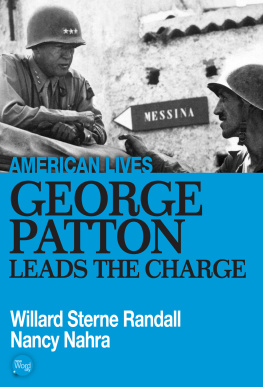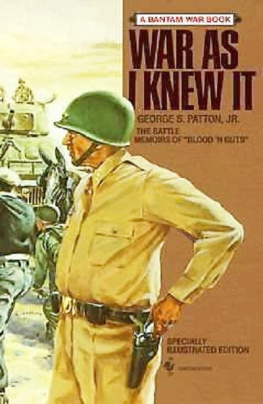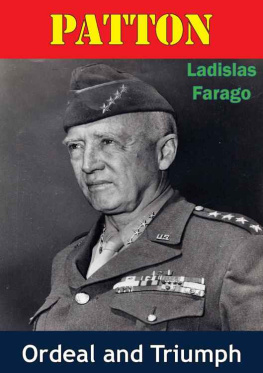Patton George Smith - Patton: A Biography
Here you can read online Patton George Smith - Patton: A Biography full text of the book (entire story) in english for free. Download pdf and epub, get meaning, cover and reviews about this ebook. City: New York;United States, year: 2009, publisher: St. Martins Press;Palgrave Macmillan, genre: Non-fiction. Description of the work, (preface) as well as reviews are available. Best literature library LitArk.com created for fans of good reading and offers a wide selection of genres:
Romance novel
Science fiction
Adventure
Detective
Science
History
Home and family
Prose
Art
Politics
Computer
Non-fiction
Religion
Business
Children
Humor
Choose a favorite category and find really read worthwhile books. Enjoy immersion in the world of imagination, feel the emotions of the characters or learn something new for yourself, make an fascinating discovery.

- Book:Patton: A Biography
- Author:
- Publisher:St. Martins Press;Palgrave Macmillan
- Genre:
- Year:2009
- City:New York;United States
- Rating:5 / 5
- Favourites:Add to favourites
- Your mark:
- 100
- 1
- 2
- 3
- 4
- 5
Patton: A Biography: summary, description and annotation
We offer to read an annotation, description, summary or preface (depends on what the author of the book "Patton: A Biography" wrote himself). If you haven't found the necessary information about the book — write in the comments, we will try to find it.
Patton: A Biography — read online for free the complete book (whole text) full work
Below is the text of the book, divided by pages. System saving the place of the last page read, allows you to conveniently read the book "Patton: A Biography" online for free, without having to search again every time where you left off. Put a bookmark, and you can go to the page where you finished reading at any time.
Font size:
Interval:
Bookmark:


The author and publisher have provided this e-book to you for your personal use only. You may not make this e-book publicly available in any way. Copyright infringement is against the law. If you believe the copy of this e-book you are reading infringes on the authors copyright, please notify the publisher at: us.macmillanusa.com/piracy.
Palgraves Great Generals Series is an important and inspiring contribution to our understanding of modern-day warfare. Every book in the series will provide invaluable insight into the legacies of eminent military leaders and take the reader on a gripping tour of the most spectacular maneuvers, missions, and battles in world history.
Gen. Wesley K. Clark
This distinguished new series will feature the lives of eminent military leaders who changed history in the United States and abroad. Top military historians will write concise but comprehensive biographies including the personal lives, battles, strategies, and legacies of these great generals, with the aim to provide background and insight into todays armies and wars.
Patton by Alan Axelrod
Grant by John Mosier
Eisenhower by John Wukovits
Lemay by Barrett Tillman
MacArthur by Richard B. Frank
Stonewall Jackson by Donald A. Davis
For Anita, as always
T HE WORLD HAS CHANGED SIGNIFICANTLY SINCE George Pattons day, as has warfare. The struggle for imperial dominance that led to World War I continued as Germany fought for recovery and revenge in World War II. But the advent of the atomic bomb marked the beginning of mutual deterrence between potential adversaries in the west and the Soviet Union. The risks of nuclear escalation were so daunting that the struggle for world dominance was carried on largely by subterfuge and proxy wars fought on the margins of Western civilization.
But while there were no more World Wars, the United States was engaged in action after action, some difficult and bloody, others marked by nuance and maneuver. Still, these were operations Patton would surely have recognized as his ownforces with armored vehicles and air support, often engaged in intense ground combat. Indeed, there were battles in Koreathe breakout from the Pusan perimeterand in Vietnamthe incursion into Cambodiathat could have been lifted straight from Pattons playbook.
American military interests in Korea, Vietnam and during the fortyyear Cold War were in many ways the legacy not just of Pattons generation, but rather of Patton himself. Pattons tactical vision for maneuver warfare suffused the postWorld War II US Army. His former subordinates and family kept alive not only his reputation but also his principles and spirit.
When the army built its first postwar tank, it was named for Patton. And at many an army post there was a Patton Hall, a Patton barracks, or a Patton museum. The spirit of maneuver warfare, and the use of combined arms, including airpower, as taught by Patton, became hallmarks of army war-fighting doctrine. Pattons tough training regimen became the stuff of legend, with a whole generation of officers claiming to carry his torch. One of the armys greatest chiefs of staff, he was best known for his leadership of the tank battalion that spearheaded Third Armys relief of Bastogne during the Battle of the Bulge. In the case studies of battles and leadership at the U.S. Army Armor School at Fort Knox, Patton was simply lionized.
At the US Military Academy, some fifty classes of West Pointers have walked daily past the inspirational statue of Patton in front of the library. With his feats near enough to make us glance over self-consciously, we dreamed and prayed that we might have the opportunity and courage to live up to his legacy.
After the difficult decade of the Vietnam War, as the army struggled to recover its bearings, army leaders returned to the foundations laid by Patton: the Desert Training Center. Just a few miles north of where Patton located his training camp in 1942, the army created a National Training Center, dedicated to teaching the art of combined arms, maneuver warfare. I was privileged to serve there twice, the last time as its commander. At the Center we made sure that, in true Patton style, the army sought to teach better fighting techniques and develop the requirements for better equipment. The result was an army that was trained, transformed, and ready for a fight.
With the fall of the Berlin Wall in 1989, some of the restraints on the use of U.S. forces were released. Patton would have been proud of the armys sweeping maneuver to push Saddam Husseins legions out of Kuwait. He would have positively rejoiced as American armor, including a brigade from his own 2nd Armored Division, knocked out enemy vehicles from ranges of up to two miles with precision tank gunnery or defeated a large defending force at night in one of the largest tank battles in military history.
And certainly Pattons spirit was there with army generals Dave McKiernan, the Land Force Commander, and Scott Wallace, commanding V Corps, as they sped deep into Iraq to penetrate Saddams forces and seize Baghdad in the spring of 2003. Maneuver warfare, risk taking it was all there, and Patton would have been proud to acknowledge his legacy.
Technology is far advanced now, of course. Unmanned aircraft fly over the enemy and send pictures to the ground, tanks communicate by internet-like messages, and with infrared technology we own the night. But Patton would see all this as the natural evolution of warfare along his own design.
It would be a mistake to limit Pattons influence to a form of warfare. In fact, it is also his character that has exerted a magnetic pull on the officer corps. His tone-deafness to politics, his aggressive swagger, his fight where were told, win where we fight attitude marked a line of professional ethics that many officers have followed. He was the consummate professional warrior, committed to learning his profession, the master of the sword.
Despite his swagger, Patton had a large dose of self-doubt. But only fools are always certain in leadership and war, two of mankinds most unpredictable activities. Pattons willingness to admit his doubts to himself may have been a key factor in his continuing professional growth, for as you will read in the following pages, Patton was able to look over the edge of the cliff, and work to avoid the failures foreseen.
Many of my mentors at West Point and later would work hard to produce a Patton-plus mentalityhard-charging in combat, yes, but also able to deal with the intricacies of strategy and statecraft. In view of the challenges we face in peacekeeping operations today, weve never needed the Patton-plus mindset more.
Patton was a master of the media (at least most of the time), as you will read in Alan Axelrods book. For all his appreciation of and use of the media however, he also discovered that it was truly a double-edged swordthe publicity that could make a career could also finish it.
No doubt Patton would have his frustrations with the global war on terror, nation-building, and peacekeeping. In the pages that follow Axelrod describes Pattons difficulties in postwar Germany, difficulties that are reflected in our current peacekeeping missions. But Patton was a student, perpetually studying how best to accomplish each mission. And it is this mindset, more than any other, that Patton has to offer todays leaders. He was a winner, a morale- and team-builder who adapted quickly and sought to master every challenge. We need leaders like that today.
Font size:
Interval:
Bookmark:
Similar books «Patton: A Biography»
Look at similar books to Patton: A Biography. We have selected literature similar in name and meaning in the hope of providing readers with more options to find new, interesting, not yet read works.
Discussion, reviews of the book Patton: A Biography and just readers' own opinions. Leave your comments, write what you think about the work, its meaning or the main characters. Specify what exactly you liked and what you didn't like, and why you think so.







